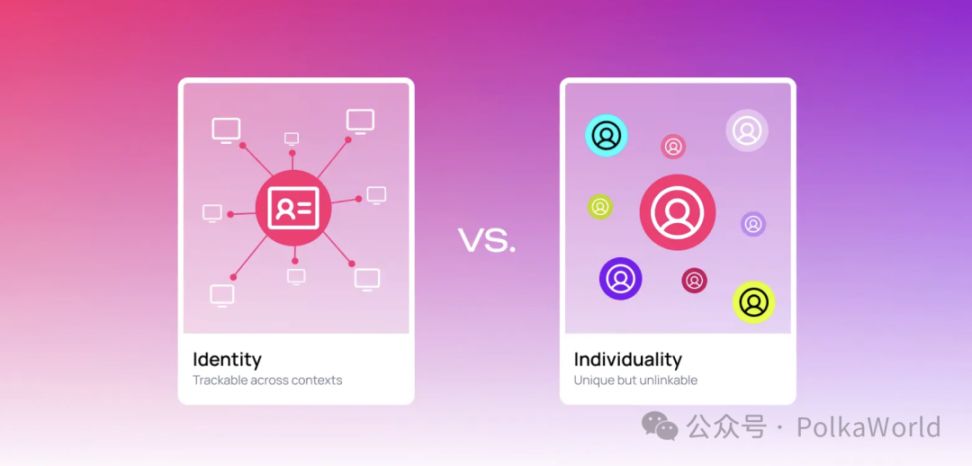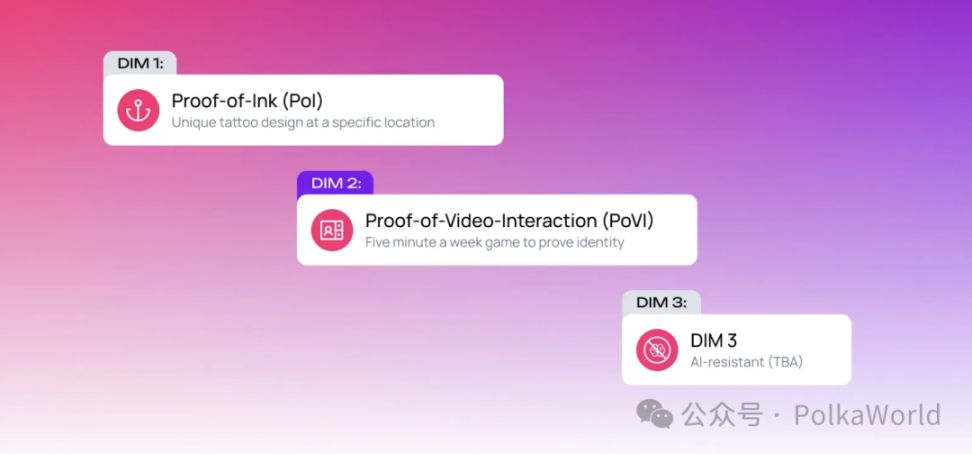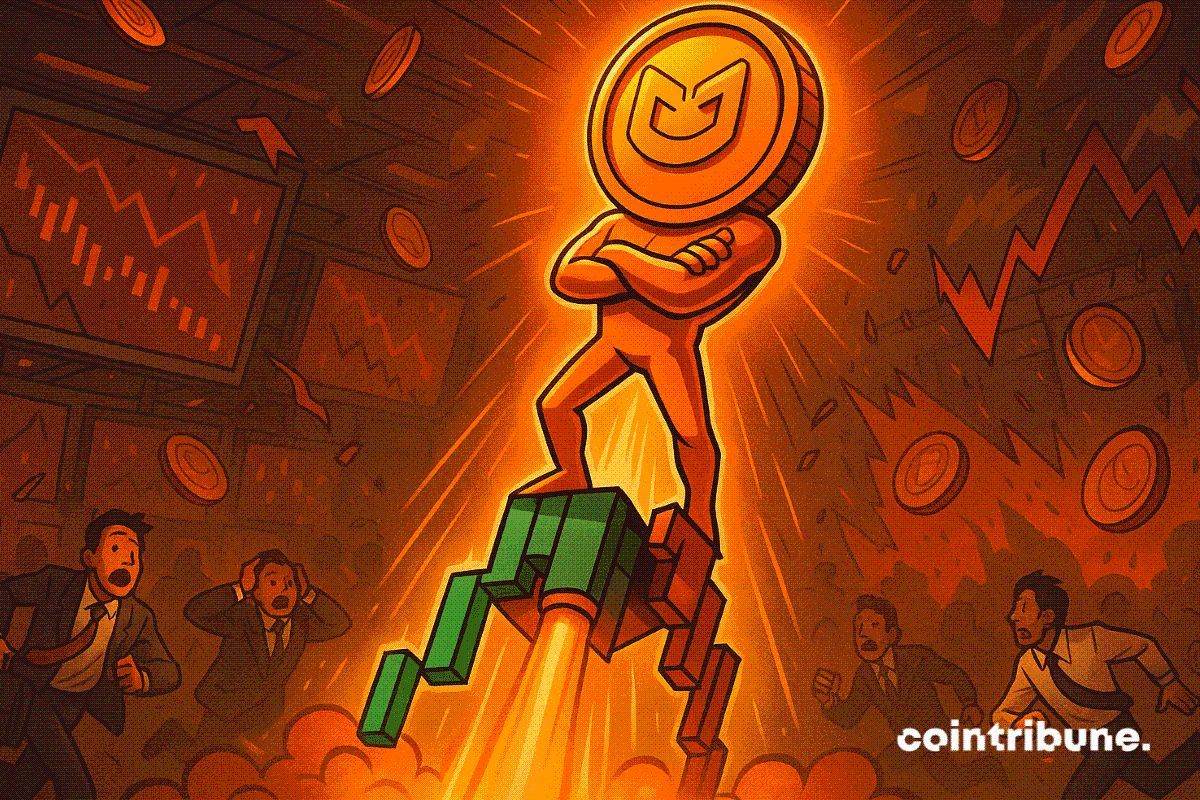Polkadot launches "KYC-free real person verification": A comprehensive analysis of Proof of Personhood!

"Proof of Personhood" is a way to prove you are a unique, real human without revealing your privacy. Polkadot's Project Individuality boldly uses tattoos and mini-games to distinguish humans from bots, bringing truly fair airdrops to millions of users.
In this article, you will learn about:
- What is Proof of Personhood
- How Polkadot's Project Individuality works
- The role of Decentralized Individuality Mechanisms (DIMs)
- The $3 million global on-chain incentive program
- Why Proof of Personhood could be a key piece for Web3
- The doubts and challenges it faces
Today, every time you log into a website, enter a captcha, or bind your phone number, you are actually participating in an invisible "human vs. bot" war. As AI capabilities improve, it becomes increasingly adept at impersonating humans, rendering traditional verification methods less effective. Web2's response is to ask for more of your personal information: email, phone, ID, and even biometrics.
But is there a way to prove you are a unique real person without exposing any privacy?
In the crypto world, this is almost a matter of life and death:
- Airdrops are often farmed by studios controlling thousands of wallets
- Governance votes are manipulated by Sybil attacks
- Free services cannot exist because you can't distinguish "100 real people" from "one script running 100 accounts"
Thus, protocols are left with two choices: either give up fairness and let the airdrop farmers win, or give up privacy and enforce KYC. This dilemma makes it hard for crypto to achieve true mass adoption.
The value of Proof of Personhood lies in breaking this deadlock.
This is also the core idea behind Polkadot founder Gavin Wood's referendum #1783, proposed in November 2025. He applied to the treasury for $3 million to launch what he calls "the fairest airdrop in history": bringing millions of new users to Polkadot, not through assets or trading history, but simply by proving they are real, independent individuals.
Next, this article will help you understand the principles of Proof of Personhood, Polkadot's specific implementation, and why it could fundamentally change Web3's identity system, privacy protection, and user participation models.
What is Proof of Personhood?
"Proof of Personhood" refers to a digital method for verifying whether an online account or action is controlled by a real and independent human, rather than a bot, script, or AI.
Unlike traditional identity systems that track "who you are" and continually bind your personal information across scenarios, Proof of Personhood only cares about one thing: whether you are an independent individual, without exposing any private information.
The Sybil Attack Problem
Proof of Personhood aims to solve the so-called "Sybil attack"—
That is, an attacker creates a large number of fake identities to manipulate the system, illegally obtain rewards, or generate spam traffic on the network.
Typical examples include:
- One person controls 10,000 bot accounts to farm airdrops
- Stuffing fake votes in online voting
- Using fake traffic to crash servers
Web2 platforms usually respond to such attacks with increasingly privacy-invasive verification methods:
- Phone number
- Facebook account
- Credit card
- Government-issued ID
The stronger the verification, the more privacy you give up. As Gavin Wood said in a Space Monkeys podcast:
"Web2 solves the Sybil attack problem by sacrificing privacy. For Web3, this is unacceptable."
Identity vs. Individuality

Understanding the difference between these two is crucial:
- Identity systems: For example, passports or social security numbers assign you a unique identifier that follows you everywhere, allowing your actions to be tracked across platforms.
- Individuality systems: The goal is not "who you are," but to count how many independent people there are, without linking your actions across different services.
To achieve free services, fair airdrops, and new governance models—the ideals of Web3—we need a "strong, economically verifiable anti-spam mechanism" that does not rely on centralized identity providers or build biometric databases.
This is exactly the new direction Gavin Wood proposes: enabling the system to confirm "one person is one person" without sacrificing privacy.
How does Polkadot's Project Individuality work?
Project Individuality is Polkadot's Proof of Personhood system, built by the Parity team over three years.
It runs on a dedicated system chain, the Polkadot People Chain, managed by Polkadot's decentralized governance—not any company or organization.
Core Principle: Contextual Aliases + Zero-Knowledge Privacy
The key to this system is a technology called "contextual aliases." Simply put:
- You generate a brand new identity in each app, protocol, or service
- These identities are completely unlinked
- But the system can still confirm they all come from "the same real person"
In other words, it can confirm you are a "unique person," but never knows "who you are." No need for:
- Web2 login
- Phone number
- ID document
- Bank information
Everything is verified using zero-knowledge cryptography, exposing none of your personal information.
Gavin describes it like this: it's as if you wear a mask to a party, and every time you enter a room, you automatically get a new name tag. Each room only sees your behavior in that room; if you misbehave, they can kick you out. But they:
- Can't know what you're called in other rooms
- Can't track you
- Can't link your behaviors
- Your different identities are mathematically un-linkable.
Not just for Polkadot, but built for the entire Web3 ecosystem
Project Individuality naturally enjoys Polkadot's advantages:
- Shared security
- Low cost
- System-level trusted execution
But its goal is not just Polkadot, but the entire Web3 world.
Through cross-chain infrastructure like Snowbridge and Hyperbridge, this "proof of individuality" mechanism can be used by other blockchains in the future, becoming a kind of "public blockchain utility."
Decentralized Individuality Mechanisms (DIMs)

Project Individuality does not rely on a single verification method, but adopts multiple Decentralized Individuality Mechanisms (DIMs) to prove that a "real person" can only have one identity. Gavin describes these mechanisms as "individuality games"—the goal is to make it difficult or extremely costly for "one person to pretend to be multiple identities."
DIM 1: Proof-of-Ink (PoI)
The first mechanism, PoI, requires users to get a tattoo—but not just any tattoo, it must be a unique, randomly generated on-chain pattern. How does PoI work?
- The blockchain generates billions of unique geometric tattoo designs
- When you apply for verification, the system gives you 100 patterns unique to you
- You choose one and tattoo it on a specified location (inside of the left forearm)
- You need to submit a video of the tattooing process, plus photos of the tattoo and its location
Gavin explained at Web3 Summit 2024:
"This tattoo must be a unique pattern specified by the chain... and it must be tattooed in a fixed location. Because everyone only has one of this body part."
PoI is the system's "bootstrapping" mechanism. It uses the high cost of tattooing to select the initial batch of strongly verified real individuals.
These "first batch individuals" act as on-chain oracles, responsible for judging whether others' submitted evidence is real. Gavin calls this "mob rule": relying on many real individuals, not centralized institutions, to review evidence.
DIM 2: Proof-of-Video-Interaction (PoVI)
The second mechanism does not require tattoos and has a lower threshold. How does PoVI work?
- Spend about 5 minutes each week playing a simple, silent interactive mini-game
- Join a synchronized video call with 15 other participants worldwide
- Continued participation maintains your individuality credibility
- Stopping participation causes your "individuality score" to gradually decrease
The proposal states: "This game is fun, easy to participate in, and very simple."
PoVI relies on the cost of ongoing participation—making impersonation require long-term, repeated effort.
The Challenge of AI and Economic Reality
Gavin admits that as AI video generation improves, both PoI and PoVI may face AI forgery threats in the next 2–5 years. But he also points out: even if AI gets stronger, paying a human $1 to complete a 5-minute task may still be cheaper than running a complex AI system.
The entire system is designed with this economic reality in mind.
Third Mechanism (Not Public Yet)
Gavin mentioned that a third DIM is under development, which will be "fully AI-resistant," but details are still confidential.
Having multiple mechanisms in parallel makes the system more secure and allows users to choose the verification method that suits them best.
Polkadot's $3 Million Large-Scale User Onboarding Plan
Polkadot referendum #1783 requests $3,009,600 (converting USDT/USDC on Asset Hub into HOLLAR stablecoin) to launch the "Polkadot Large-Scale User Onboarding Campaign."
This budget will be distributed automatically according to on-chain preset logic, without any approval from Parity or anyone else—truly fully automated and intermediary-free.
The incentive system is divided into three parts
1. Bootstrapping Rewards: Attracting the first batch of users
To overcome the "cold start" problem of the proof of individuality system, early users will receive higher rewards:
- Earliest users: $200
- Mid-phase users: $100
- Late-phase users: $50
By "the earlier you join, the more you get," users are encouraged to join the People Chain system quickly.
2. Governance Participation Rewards: Encouraging ongoing activity
As long as you stay active and participate in governance on Polkadot, you can earn about $10 in rewards each week.
Gavin explained in a livestream that this mechanism is not for one-off user acquisition, but to "keep users in Polkadot for the long term, not just for a one-time snapshot."
3. Weekly Lottery: The largest part of the total budget
To maintain high-frequency user participation, most of the budget is used for a lottery mechanism:
- About 140 people per week can win about $250
- There is also a special $2,500 grand prize each month
- The system limits winning frequency to ensure each user's chance of winning does not exceed 1/10
This design makes incentives more exciting and avoids the unfairness of "perpetual winners."
This is not a simple airdrop, but part of a comprehensive ecosystem strategy
Gavin emphasized in the proposal that this plan is not just an "incentive," but an ecosystem-level growth strategy linked with several of Polkadot's core products.
- Project Individuality will be integrated into the Polkadot mobile app, allowing new users to quickly register and verify.
- Polkadot Hub's smart contract platform will use this mechanism to enable zero-fee transfers, free use of some services, and fairer access to applications.
- Gavin's "New Deal" staking plan allows users to participate in network security through "individuality," without the high capital threshold of traditional staking.
Gavin wrote in the proposal: "Unlike almost all previous user growth proposals in OpenGov, this time, not a single cent goes to intermediaries. Every dollar is distributed directly to users, and all interactions happen on Polkadot."
The KPI for this campaign is very clear: to bring a large number of real users into the Polkadot ecosystem and keep them there.
Why is "Proof of Personhood" critical for Web3?
Strong proof of individuality will unlock many Web3 scenarios that were "theoretically feasible but impossible to implement fairly" in reality.
1. Fairer airdrops
Today's airdrops are usually distributed based on trading history, on-chain activity, or token holdings. As a result, veteran players, people with multiple wallets, and specialized "airdrop studios" often get most of the rewards.
With proof of individuality, projects can truly distribute tokens to independent real individuals, without relying on users' "credentials" or "on-chain assets."
This will bring:
- Fairer distribution
- More authentic community building
- Avoiding rewards being "dominated" by professional airdrop teams
2. Free services become possible
If you can distinguish 100 real users from one person controlling 100 bot accounts, you can provide free services without worrying about system abuse.
Gavin gave an example: zero-cost transfers—send $50 to a friend, and they receive $50, not $49.98.
On Polkadot Hub, this means:
- Truly free-to-use dApps
- No gas fees
- No hidden charges
- User experience as convenient as Web2
3. New governance models
When you can confirm "one person is one independent individual," traditional "token-weighted governance" is no longer the only option.
Polkadot can experiment with:
- Quadratic Voting
- One-person-one-vote for specific funding pools
- FutaGov (future governance, dynamically adjusting voting rights based on performance)
Gavin even suggested in a Space Monkeys interview to start with small-scale pilots: "Keep the main treasury unchanged, set up a sub-treasury with 500,000 DOT... same rules as the main treasury, but one-person-one-vote."
This will open up a whole new space for governance experiments.
4. Real breakthroughs for games and social apps
Large-scale multiplayer games (MMOs) want to give out free starter packs, but can't distinguish:
- Real players
- Thousands of alt accounts run by the same person
Social networks want to build credible reputation systems, but most accounts can be discarded or changed at any time.
Proof of individuality makes the following possible:
- Preventing multi-account abuse
- Building a reputation network of real individuals
- Making rewards, upgrades, and matchmaking systems fairer
5. Building an "Agentic Society"
The grander vision is what Gavin calls an "Agentic Society":
- A trustworthy digital society,
- Where interactions come from real, independent individuals,
- Not automated scripts, bots, or mass accounts.
This lays the foundation for a more "human-centric internet."
Challenges and Doubts: Why is the community so divided?
This proposal sparked extensive discussion within the Polkadot DAO, with community members raising concerns about execution, cost, and security.
1. Unclear metrics: What are the goals?
Many commenters pointed out that this $3 million "mass activation plan" lacks clear metrics, such as:
- How many users to verify?
- How long will users participate?
- What is the retention target?
In addition, the promised integration of Project Individuality into the Polkadot Mobile App has not yet been publicly released, raising concerns about project readiness and execution timelines.
2. AI impact is a real risk
Gavin himself admits that as generative AI improves:
- Proof-of-Ink
- Proof-of-Video-Interaction
Could be forged by AI within 2–5 years.
Although Gavin believes that, in the short term, paying a real person to do the task is still cheaper than using AI, this advantage window is closing. The third "AI-resistant" mechanism has not been announced, and it's unclear if it can fill the gap in time.
3. Economic attacks: What if people pay real humans to farm?
A common concern is "economic abuse." For example, someone suggested: "Set up a booth outside a school, pay each student $10 to complete verification. You get the reward, students get $10."
In some regions, even $10 or $250 is very attractive income, which could lead to:
- Volume farming
- Paid participation
- Group outsourcing of verification
Thus undermining the system's fairness and credibility.
4. HOLLAR controversy: Why must it be converted to the ecosystem stablecoin?
The proposal requires converting treasury funds to HOLLAR, which confuses some community members:
- Is this step necessary?
- Does it give the impression of "using the treasury to promote a specific project"?
Although the proposal explains this is to promote internal ecosystem circulation, doubts remain.
5. Usability vs. Security: A tough trade-off
The system must be easy for the public to participate in, yet have strong Sybil resistance—this is hard to achieve simultaneously.
For example:
- Proof-of-Ink requires a permanent tattoo, which many people are unwilling to do
- Proof-of-Video-Interaction requires regular video interaction, which is troublesome in privacy-sensitive or low-connectivity regions
How to achieve "mass adoption and security" remains the biggest challenge.
Conclusion: This is an experiment different from traditional KYC
Proof of Personhood is completely different from traditional KYC:
- KYC: Proves "who you are"
- PoP (Proof of Personhood): Only proves "you are a unique person"
Polkadot, with its low cost, high security, and strong interoperability infrastructure, is well-suited for this kind of large-scale experiment.
Referendum #1783 is still under discussion, with the community weighing the potential for massive user growth against execution risks and uncertainties.
Project Individuality is planned to launch in Q4 2025, with more mechanisms to be released in 2026.
Whether or not the proposal passes, this is the first time the Web3 world has seriously tried to answer a key question:
How can millions of "real people" enter the blockchain world while protecting privacy?
The internet of the future may not need you to prove "who you are," but only that you are real.
Disclaimer: The content of this article solely reflects the author's opinion and does not represent the platform in any capacity. This article is not intended to serve as a reference for making investment decisions.
You may also like
Trump Ally Kevin Hassett Tipped To Lead The Fed

Bitcoin : Are the conditions for a future bull run already met?


Research Report|In-Depth Analysis and Market Cap of Irys (IRYS)

